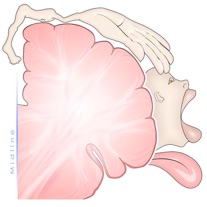Sensation and movement of different parts of the body are controlled by different areas of the brain. For instance, when you move your index finger, a specific area on the top of your brain triggers a signal that tells the muscles on your index finger to move. When you touch something with your index finger, a neighboring area of your brain receives a signal about that touch sensation.
Look at your hand. Now look at your arm. Which is bigger? Your arm, right? Does that mean your arm has larger area of the brain devoted to its control? Actually, no. Sensations and movements of your hand are controlled by more of your brain than sensations and movements of your arm. This larger area allows you to make finer movements and a have better sense of touch.
The area of your brain devoted to each body part is represented in the homunculus by how large each body part is. Looking at the illustration above, it should now make sense to you why the lips and tongue are so large and the knee is so small. Your lips and tongue are specialized for making small, precisely controlled movements (like when you speak), whereas your knee makes larger, less precise movements. Make sense?





















